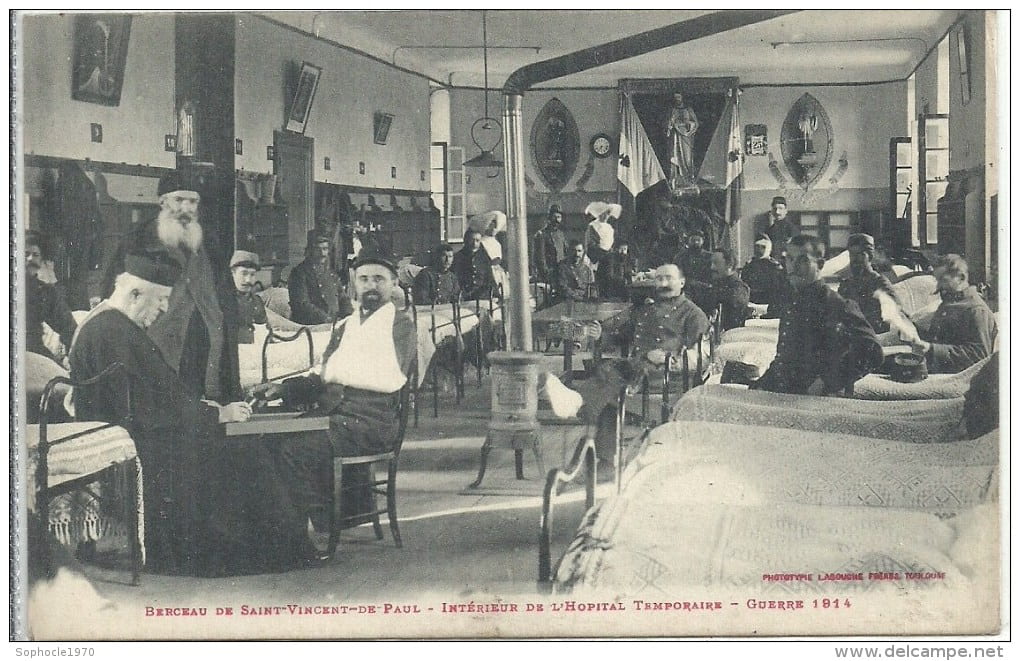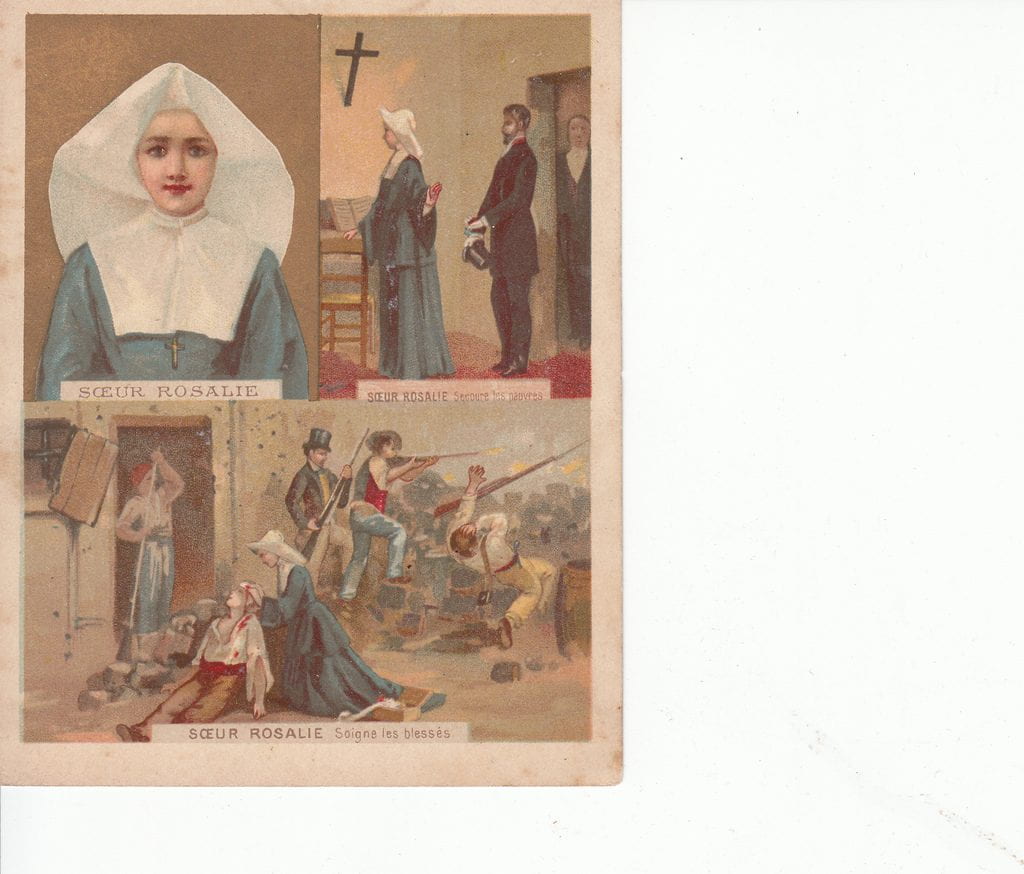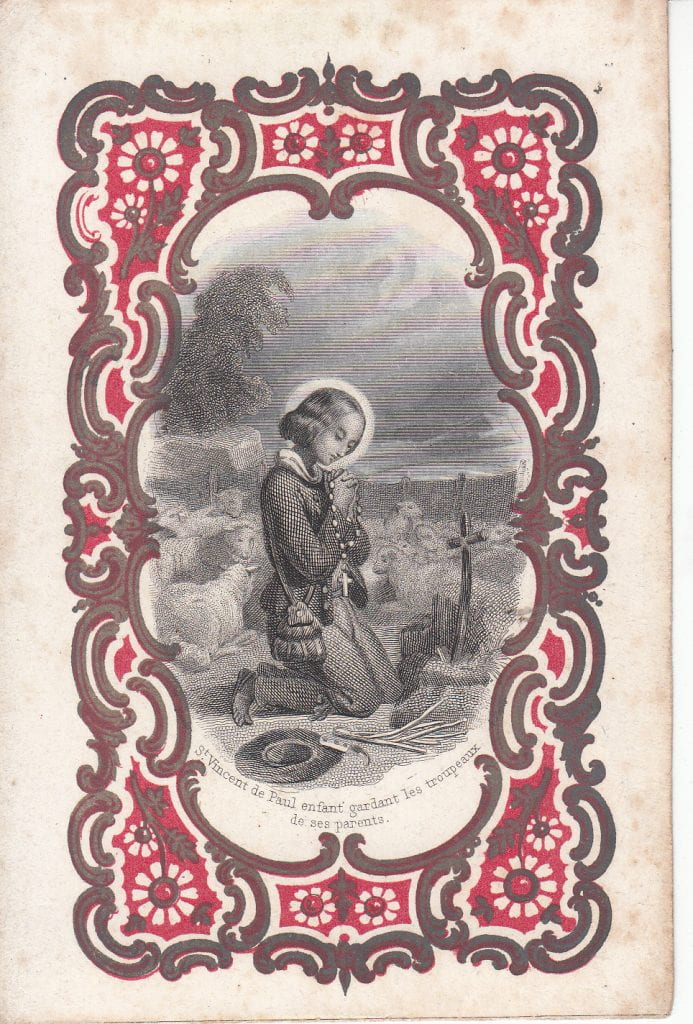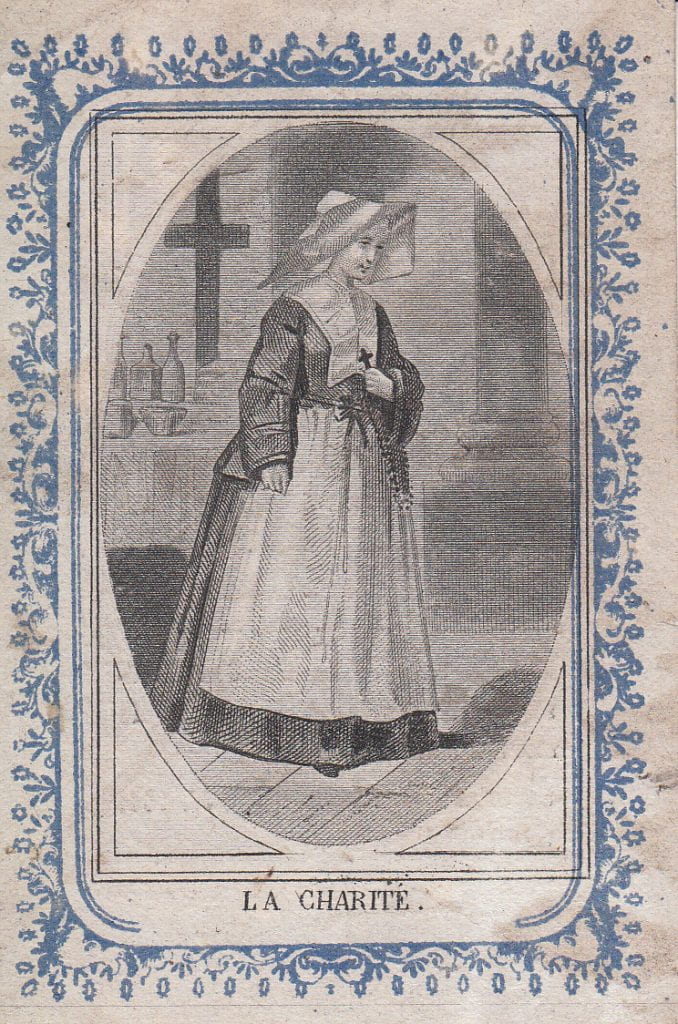It has been recently announced that the feast of Louise de Marillac has been moved to May 9th (the anniversary of her beatification in 1920). We have been able to find a number of commemorative postcards from her beatification celebrations. Today’s postcard is from the Church of Notre Dame du Rosaire in Tunis, Algeria. Algeria was a french colony from 1830 to 1962, and the French colonists established a colonial version of French Catholicism including, dioceses, convents, monasteries, schools, and parishes. Most of these disappeared with the end of the colonial period. The Lazaristes and Filles de la Charites were part of this implanted religious colonialism. This postcard reminds us of this chapter in French imperial history and French religious imperial history as well.
Holy Card
Newsnote: Vincentiana Purchase of the Week: 19th century French Daughter of Charity mortuary card
This newly-acquired mid-to-late 19th century French card was among those designed to be used as memorial cards for deceased Daughters of Charity. The card depicts a Daughter being guided to heaven by Saint Vincent de Paul to be received by the Savior. The Vincentiana collection at the Archives and Special Collections Department of DePaul University’s Richardson Library now has a number of these cards in its collection.
Newsnote: Vincentiana Purchase of the week: Rare 19th century holy card of Vincent de Paul
This mid-to-late 19th century, color, holy card has an unusual depiction of St. Vincent on a battlefield
with confreres and a Daughter of Charity ministering in the background. This is no doubt inspired by a similar original 18th century painting from Saint-Lazare now in the parish church of Sainte-Marguerite in Paris. The legend at the bottom of the card reads: “St. Vincent communicated his spirit so well to his children that they braved famine and the plague to care for the wounded and dying.”
This card was recently acquired for the Vincentiana collection in the Archives and Special Collections Department of DePaul University’s John T. Richardson Library.
Vincentiana Purchase of the Week: Rare Rosalie Rendu Holy Card
This rare late 19th century postcard of Rosalie Rendu does not use the familiar mature portrait image of Rosalie but pictures Rosalie as a younger sister. There is also a scene from the barricades of the Revolution of 1848, and a scene with two members of what is presumably the Saint Vincent de Paul Society. One of these gentlemen can be presumed to be Frederic Ozanam.
Newsnote: “Vincentiana Purchase of the Week.” A saint from the cradle
The Vincentiana Collection at Archives and Special Collections of DePaul University’s John T. Richardson Library recently purchased this unique mid-to-late nineteenth century holy card. The card depicts Vincent de Paul as a very young boy. According to legend, as a young boy, Vincent de Paul gave a beggar all of the money he had saved. This card names the amount: “30 sous” and associates it with a previously unknown part of the legend: the young Vincent tending his father’s flocks and praying before a rustic cross he has hand-fashioned. This prayer inspires him to this act of charity. The height of 19th century French Romanticism.
Newsnote: Vincentiana Purchase of the Week 8/17/2015 St. Vincent’s original parish church: Pouy
This small rare sepia photograph was recently acquired by the Vincentiana Collection at DePaul University’s Archives and Special Collections. The photograph shows the original parish church at Pouy (near Dax) where St. Vincent was baptized and where he presumably also made his first communion. The town was renamed Saint Vincent de Paul in the 19th century to honor its most famous son. The photograph dates sometime before 1913 when the church had to be torn down because of severe storm damage. Other picture postcards survive but all show the church from the angle of the flood plain below.
Book of the Week: “Dictionnaire Richelieu”
From the publisher: «Premier ministre de Louis XIII » et « fondateur de l’Académie française » : tels sont les titres associés à la figure d’Armand Jean du Plessis (1585-1642), cardinal-duc de Richelieu, sur les plaques de rue qui affichent son nom au coeur de Paris. Ce ne sont que les plus connus d’un grand nombre de titres acquis ou attribués à ce célèbre homme d’État et d’Église dont la vie, l’histoire et la légende se composent de mille et une facettes. Ce Dictionnaire invite le lecteur à les découvrir ou à les redécouvrir autrement à travers cent vingt notices rédigées par cinquante-sept spécialistes du Cardinal et de son époque. Replacé dans son contexte français, européen et, parfois même, mondial, chaque sujet abordé renvoie à plusieurs autres dont la lecture – complémentaire ou indépendante de celle d’une biographie de Richelieu – permettra à tout un chacun d’aborder, selon ses besoins et envies, la réflexion et l’action de celui qui avait largement contribué à l’avènement du Grand Siècle. Publisher: Honore Champion, Paris Pages: 400 ISBN: 9782745328663 70,00 Euros
Newsnote: “More of World War I and the community in France: The Berceau.”
 This postcard image from 1914 depicts one of the student dormitories at the Berceau of Saint Vincent de Paul (near Dax) temporarily transformed into a military hospital (hopital auxiliaire). Daughters of Charity from the orphanage and hospice served as nurses. In the left hand lower corner a confrere (wearing a biretta) plays a board game with one of the wounded soldiers. This postcard was recently acquired by the Vincentiana collection at the Archives and Special Collections at DePaul University in Chicago.
This postcard image from 1914 depicts one of the student dormitories at the Berceau of Saint Vincent de Paul (near Dax) temporarily transformed into a military hospital (hopital auxiliaire). Daughters of Charity from the orphanage and hospice served as nurses. In the left hand lower corner a confrere (wearing a biretta) plays a board game with one of the wounded soldiers. This postcard was recently acquired by the Vincentiana collection at the Archives and Special Collections at DePaul University in Chicago.
Newsnote: “Vincentiana Purchase of the Week” Daughter of Charity = Icon of Charity
In the mid-19th century Jean-Baptiste Etienne, C.M., the superior general of the Daughters of Charity (1843-1874) was determined that the figure of the Sister of Charity would become the general symbol for all Catholic charity. This mid-19th century holy card depicts the accomplishment of this goal. This card was recently purchased for the Vincentiana Collection at Archives and Special Collections, DePaul University, Chicago, Illinois. This collection is the largest in the world.
Newsnote: “Vincent de Paul. Un saint au Grand Siecle.”
Petit paysan des Landes devenu prêtre, nommé précepteur dans l’illustre famille de Gondi après diverses aventures, Vincent de Paul, né en 1581, découvre à trente-six ans la vocation de sa vie : servir les pauvres. Aumônier général des galères du roi à partir de 1618, il fonde en 1625 la congrégation de la Mission, afin d’évangéliser et soigner le peuple des campagnes, et former des prêtres pour cette tâche. En 1632, il se voit offrir avec sa communauté le prieuré de Saint-Lazare à Paris. Les lazaristes étaient nés. Leur ordre allait devenir un refuge pour des milliers de démunis et un centre de rayonnement spirituel considérable.
Peu à peu, Vincent de Paul s’affirme comme la conscience de son temps. Avec Louise de Marillac, supérieure des Filles de la Charité, il suscite l’engagement et la générosité des femmes de la haute société, lutte sur le terrain contre les horreurs de la guerre de Trente Ans, institue à Paris l’oeuvre des Enfants trouvés. Par sa présence, de 1643 à 1652, au Conseil de conscience de la reine Anne d’Autriche, celui qui fait jeu égal avec les grandes figures de la Contre-Réforme catholique, François de Sales, Bérulle, Olier, influera aussi sur les affaires de l’Etat et s’engagera contre le jansénisme. Les années 1650 le voient jouer un rôle décisif dans le développement des missions étrangères. Il meurt en 1660 et sera canonisé moins d’un siècle plus tard.
Homme de prière, homme d’action, meneur d’hommes, témoin auprès des grands des exigences de la conscience, l’humble paysan gascon est devenu une grande figure de notre histoire.









